IASbaba's Daily Current Affairs Analysis
Archives
(PRELIMS + MAINS FOCUS)
ASEAN Phd Fellowship Programme (APFP)
Part of: GS Prelims and GS-II – International Relations
In news
- Recently, the students from ASEAN member states who have been selected for the prestigious ASEAN PhD Fellowship Programme (APFP) were virtually addressed.
- The program is funded by the Government of India.
Important value additions
The ASEAN PhD Fellowship Programme was (APFP)
- It was announced on 25th January 2018, by Indian Prime Minister in the presence of leaders of ASEAN member states.
- Under the APFP, 1,000 fellowships will be provided exclusively to the ASEAN citizens.
- It is also the largest capacity development programme undertaken by the Government of India for foreign beneficiaries.
- It will open many doors in the field of technology and research for the academicians, researchers and the scientists from India and ASEAN.
- The students of the ASEAN member states have got the opportunity to study in the IITs.
Do you know?
ASEAN countries: Brunei, Cambodia, Indonesia, Laos, Malaysia, Myanmar, Philippines, Singapore, Thailand and Vietnam.
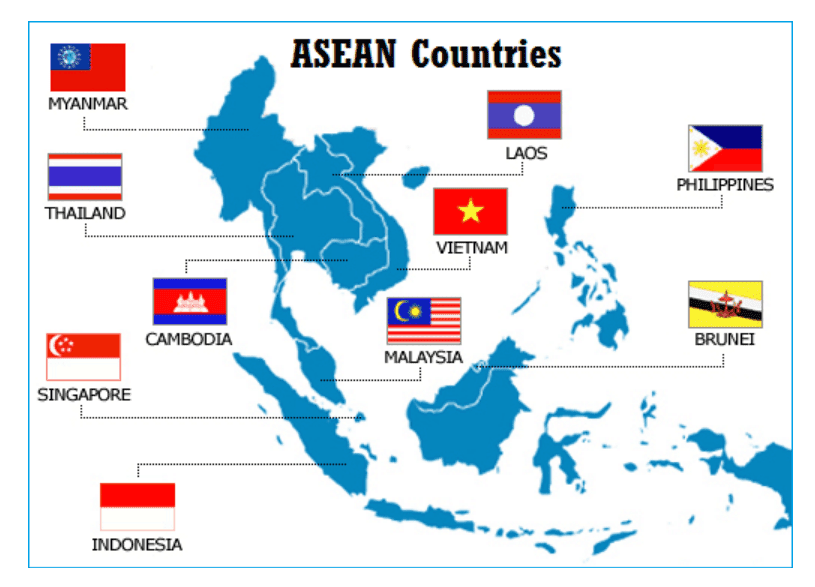
Kapila Campaign launched
Part of: GS Prelims and GS-II – Education & GS-III – Intellectual Property
In news
- The Ministry of Education launched the ‘KAPILA’ (Kalam Program for Intellectual Property Literacy and Awareness) campaign on the 89th birth anniversary of former President and Scientist Late Dr. APJ Abdul Kalam.
Key takeaways
- Under this campaign, students pursuing education in higher educational institutions will get information about the correct system of application process for patenting their invention and they will be aware of their rights.
- The Institution Innovation Council (IIC 2.0) annual report was also presented on the occasion.
- The launch of IIC 3.0 and its website were also announced.
- It has also been decided to celebrate the week of October 15th to 23rd as ‘Intellectual Property Literacy Week’.
Do you know?
- The Institution Innovation Council was established by the Ministry of Education in 2018.
- IICs have been established in about 1700 higher educational institutions.
- They will be established in 5000 higher educational institutions under IIC 3.0.
Directorate General of Shipping notified as National Authority For Recycling Of Ships
Part of: GS Prelims and GS-III – Economy
In news
- The Central Government has recently notified the Directorate General of Shipping as National Authority for Recycling of Ships under section 3 of the Recycling of Ships Act, 2019.
Key takeaways
- As an apex body, DG Shipping is authorised to administer, supervise and monitor all activities related to ship recycling.
- DG Shipping will be the final authority for the various approvals.
Do you know?
- Under Ship Recycling Act, 2019, India has acceded to Hong Kong Convention for Ship Recycling under International Maritime Organization (IMO).
- DG Shipping is a representative of India in IMO.
- All the conventions of IMO are being enforced by DG Shipping.
- National Authority of Ship Recycling will be set up in Gandhinagar, Gujarat.
- Its location will benefit the Ship Recycling yard owners situated in Alang, Gujarat which is home of Asia’s largest ship breaking and ship recycling industry in the world.
Kilo Class submarine INS Sindhuvir delivered to Myanmar Navy
Part of: GS Prelims and GS-II – International Relations
In news
- India will be delivering a Kilo Class submarine INS Sindhuvir to Myanmar Navy as part of defence cooperation.
- This will be the first submarine of the Myanmar Navy.
Key takeaways
- Cooperation in the maritime domain is an important part of India’s enhanced engagement with Myanmar.
- It is in accordance with India’s vision of SAGAR (Security and Growth for All in the Region) and in line with build capacities and self-reliance in all the neighbouring countries.
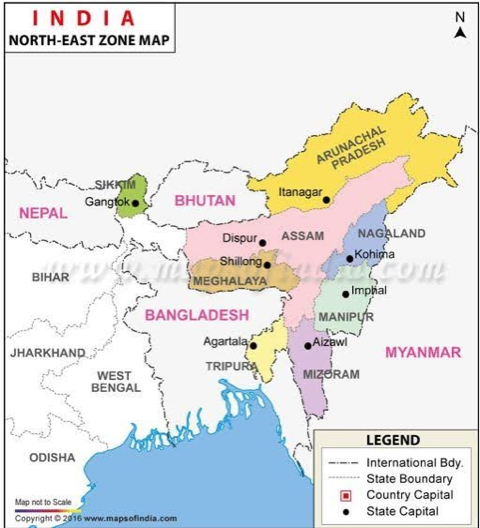
Do you know?
- Myanmar is one of India’s strategic neighbours and shares a 1,640-kilometer-long border with a number of north-eastern states of India.
- Kilo class refers to diesel-electric attack submarines that were designed and built in the Soviet Union.
Government Bans Imports Of Air Conditioners with Refrigerants
Part of: GS Prelims and GS-III – Economy; Trade
In news
- Indian Government has banned imports of air conditioners with refrigerants in order to promote domestic manufacturing and cut imports of non-essential items.
Key takeaways
- Non-essential electronic goods have been under the purview of the Ministry of Commerce and Industry since the government decided to push for self-reliance in various sectors.
- Air conditioners have been specifically singled out by Indian Prime Minister as an example of a segment where self-reliance was required.
- In July 2020, the government had imposed restrictions on the imports of various colour TV sets as well.
Centre to Borrow on Behalf of States to meet the GST shortfall
Part of: GS Prelims and GS-II – Federalism & GS-III – Taxation
In news
- Recently, the Centre has decided to borrow an estimated revenue shortfall of Rs. 1.1 lakh crore as loans to States to meet the GST shortfall.
Key takeaways
- The borrowing will not have any impact on the fiscal deficit of the Government as the Centre is acting as mediator only.
- The Centre will borrow the loan and pass on to the states.
- The amounts will be reflected as the capital receipts of the state governments and it will be a part of financing its respective fiscal deficits.
Background of the news
- The economic slowdown due to covid-19 had reduced both GST and cess collections in FY 2019-20, due to which there was 40% gap (shortfall) between the compensation paid and cess collected.
- The Centre distinguished the GST shortfall into two types: (1) Due to GST implementation itself; (2) due to the impact of Covid-19.
- The fall of GST revenue due to Covid-19 was termed as an act of God.
- Also, the GST Compensation Act, 2017 guaranteed states that they would be compensated for any loss of revenue in the first five years of GST implementation, until 2022, using a cess levied on sin and luxury goods. It did not foresee an act of God.
- Thus, The Centre had earlier refused to compensate GST shortfall arising due to covid-19 to the states.
- In August 2020 at GST Council meet, the Centre had proposed two options to states to meet the shortfall: (1) A special window could be provided, in consultation with the RBI so that the states can get Rs. 97,000 crore at a reasonable rate of interest. The amount can be repaid after five years (of GST implementation) ending 2022 from cess collection; (2) Another option is that this entire gap of Rs. 2.35 lakh crore can be met by the borrowing by the states in consultation with RBI.
- However, many states were against these two options and were planning to move the Supreme Court over the issue.
Benefits of the recent decision
- The borrowing by the Centre would avoid differential rates of interest that individual states may be charged for their respective State Development Loans (SDLs).
- The country’s general government debt, which includes both the Centre’s and States’ borrowings will not increase due to this step.
- The States that get the benefit from the Special Window may borrow a lesser amount from the additional borrowing facility of 2% of Gross State Domestic Product under Atma Nirbhar Package.
Important value additions
Goods and Services Tax
- GST was introduced through the 101st Constitution Amendment Act, 2016.
- It is an indirect tax on the supply of final goods and services.
- It has subsumed indirect taxes like excise duty, Value Added Tax (VAT), service tax, luxury tax etc.
- It is levied at the final consumption point.
- It is levied only on the value addition.
- It is collected on goods and services at each point of sale in the supply line.
- The GST avoids the cascading effect or tax on tax which increases the tax burden on the end consumer.
- Tax Structure under GST: (1) Central GST to cover Excise duty, Service tax etc.; (2) State GST to cover VAT, luxury tax etc.; (3) Integrated GST to cover inter-state trade.
- It has a 4-tier tax structure for all goods and services under the slabs- 5%, 12%, 18% and 28%.
Supreme Court (SC) upholds the Madras High Court’s 2011 order on the Nilgiris elephant corridor
- Recently, the SC upheld the Madras HC’s 2011 order on the Nilgiris elephant corridor.
- It affirmed the right of passage of the animals and the closure of resorts in the area.
Key takeaways of the SC Judgement
- In 2011, the Madras HC had upheld the validity of the Tamil Nadu government’s notification (of 2010) declaring an ‘Elephant Corridor’ in the Sigur Plateau of Nilgiris District.
- According to SC, it’s the State’s duty to protect a “keystone species” like elephants, which are immensely important to the environment.
- Elephant corridors allow elephants to continue their nomadic mode of survival, despite shrinking forest cover, by facilitating travel between distinct forest habitats.
- These corridors play a crucial role in sustaining wildlife by reducing the impact of habitat isolation.
- The SC opined that the area is a fragile ecosystem, where the will of men must give way to elephants.
- The court has also allowed the formation of a committee led by a retired HC judge and two other persons to hear the individual objections of resort owners and private landowners within the corridor space.
Important value additions
Nilgiris Elephant Corridor
- It is situated in the ecologically fragile Sigur plateau.
- It connects the Western and the Eastern Ghats.
- It is situated near the Mudumalai National Park in the Nilgiris district.
- It also has the Nilgiri hills on its southwestern side and the Moyar river valley on its northeastern side.
- There are about 100 elephant corridors in India of which almost 70% are used regularly.
- 75% of the corridors are in the southern, central and north-eastern forests.
- There are an estimated 6,500 elephants in just the Brahmagiri-Nilgiris-Eastern Ghats ranges.
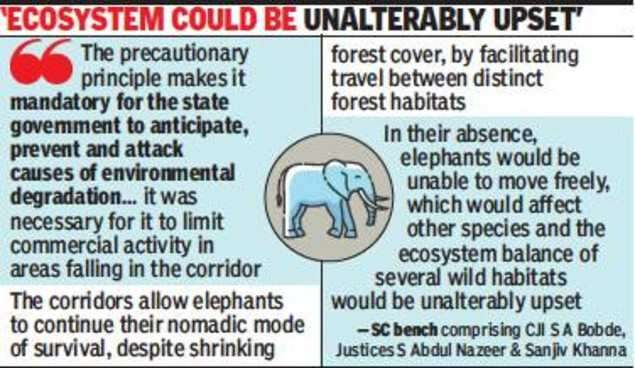
Asian Elephant
- There are three subspecies of Asian elephant – the Indian, Sumatran and Sri Lankan.
- The Indian has the widest range and accounts for the majority of the remaining elephants on the continent.
- Common threats to African and Asian elephants: Escalation of poaching, habitat loss, human-elephant conflict and mistreatment in captivity
- IUCN Red List status: (1) African elephants: vulnerable; (2) Asian elephants: endangered.
- CITES status: (1) Appendix I for Asian Elephants; (2) Appendix II for African elephants in Botswana, Namibia, South Africa and Zimbabwe.
- Conservation Efforts by India: (1) Project Elephant in 1992 as a Centrally Sponsored Scheme under which Elephant census is conducted once in 5 years; (2) Establishment of elephant reserves; (3) Adoption of the “World Elephant Day” (August 12); (4) Gaj Yatra – a awareness campaign highlight the necessity of securing elephant corridors; (5) The Monitoring the Illegal Killing of Elephants (MIKE) programme, launched in 2003, is an international collaboration that tracks trends in information related to the illegal killing of elephants from across Africa and Asia, to monitor effectiveness of field conservation efforts.
Do you know?
- Keystone species: A species that has a disproportionately large effect on the communities in which it lives.
Miscellaneous
World Food Day
- World Food Day 2020 was observed on 16 October.
- Theme: Grow, Nourish, Sustain Together
- On this day, the Food and Agriculture Organization of the United Nations was founded in 1945.
(MAINS FOCUS)
SOCIETY/ GOVERNANCE
Topic: General Studies 1,2:
- Population and associated issues,
- Government policies and interventions for development in various sectors and issues arising out of their design and implementation.
The Population Worry
Context: Recently, there has been discussion in the media on India’s population future prompted by release of the Sample Registration System (SRS) Statistical Report (2018) and global population projections made by the Institute of Health Metrics and Evaluation (IHME), US.
About Fertility Rates
- Total fertility rate (TFR)—the average number of children born per woman
- Replacement level fertility is the TFR —at which a population exactly replaces itself from one generation to the next, without migration. This rate is roughly 2.1 children per woman for most countries, although it may modestly vary with mortality rates
What is Sample Registration System (SRS)?
- The SRS is a demographic survey for providing reliable annual estimates of infant mortality rate, birth rate, death rate and other fertility and mortality indicators at the national and sub-national levels.
- Initiated on a pilot basis by the Registrar General of India in a few states in 1964-65, it became fully operational during 1969-70.
- The field investigation consists of continuous enumeration of births and deaths in selected sample units by resident part-time enumerators, generally anganwadi workers and teachers; and an independent retrospective survey every six months by SRS supervisors. The data obtained by these two independent functionaries are matched.
Key Finding of SRS Report
- The report estimated the Total Fertility Rate (TFR as 2.2 in the year 2018
- A comparison of 2011 and 2018 SRS statistical reports shows that TFR declined from 2.4 to 2.2 during this period
- Fertility is likely to continue to decline and it is estimated that replacement TFR of 2.1 would soon be reached for India as a whole
- As fertility declines, so does the population growth rate.
- Fertility declined in all major states. In 2011, 10 states had a fertility rate below the replacement rate. This increased to 14 states in 2018.
- The six states with higher than national fertility rate (and their TFR) in 2018 are Bihar (3.2), Uttar Pradesh (2.9) Madhya Pradesh (2.7), Rajasthan (2.5), Jharkhand (2.5) and Chhattisgarh (2.4)
Issue of sex ratio at birth
- The SRS reports show that sex ratio at birth in India, measured as the number of females per 1,000 males, declined marginally from 906 in 2011 to 899 in 2018.
- There is considerable son preference in all states, except possibly in Kerala and Chhattisgarh.
- This is a cause for concern because this adverse ratio results in a gross imbalance in the number of men and women and its inevitable impact on marriage systems as well as other harms to women.
Consequences of TFR reaching replacement level
- Many people believe that the population would stabilise or begin to reduce in a few years once replacement fertility is reached.
- This is not so because of the population momentum effect, a result of more people entering the reproductive age group of 15-49 years due to the past high-level of fertility.
- For instance, the replacement fertility level was reached in Kerala around 1990, but its annual population growth rate was 0.7 per cent in 2018, nearly 30 years later.
- The UN Population Division has estimated that India’s population would possibly peak at 161 crore around 2061 at the medium-fertility variant.
- Some of this momentum effect can be mitigated if young people delay childbearing and space their children.
Fertility and Social setting
Fertility largely depends upon social setting and programme strength.
- Female education is a key indicator for social setting.
- Broadly, higher the female education level, lower the fertility.
- For instance, illiterate women in the reproductive age group of 15-49 years have higher fertility than literate women in almost all states.
- The percentage of illiterate women in the reproductive age group declined from 31.5 in 2011 to 13.0 per cent in 2018 as the cohort of older women with high illiteracy exited and younger women with a high proportion of them literate entered this age group.
- Programme strength is indicated by the unmet need for contraception, which has several components.
- The National Family Health Survey (2015-16) provides us estimates for the unmet need at 12.9 per cent and contraceptive prevalence of 53.5 per cent for India. Together, this puts the total demand for contraception at 66.4 per cent.
- Bihar, with the highest fertility rate, also has the highest unmet need at 21.1 per cent and the lowest contraceptive prevalence rate of 24.1 per cent among all the major states
- Although female education levels are improving in Bihar, fertility for women with any education level is higher in 2018 compared to 2011. Likewise, fertility among women with Class 10 or higher education in UP is greater in 2018 compared to 2011.
- Programme’s ability to reach younger people and provide them with good quality reproductive health education and services needs to be urgently strengthened in these states (Bihar & UP)
Way Ahead
- Increasing female education and economic prosperity help to improve the sex ratio.
- In view of the complexity of son preference resulting in gender-biased sex selection, government actions need to be supplemented by improving women’s status in the society.
- There is an urgent need to reach young people both for reproductive health education and services as well as to cultivate gender equity norms
ECONOMY / GOVERNANCE/ INTERNATIONAL
Topic: General Studies 3:
- Indian Economy and issues relating to planning, mobilization, of resources, growth, development and employment.
India Bangladesh Per capita GDP
Context: The International Monetary Fund’s latest update on the World Economic Outlook.
Key Findings of Report
- In the IMF’s estimation, in 2020, growth of India’s gross domestic product (GDP) will witness a contraction of over 10%
- But more than the sharp contraction, what has caught everyone’s attention is that in 2020, the per capita income of an average Bangladeshi citizen would be more than the per capita income of an average Indian citizen.
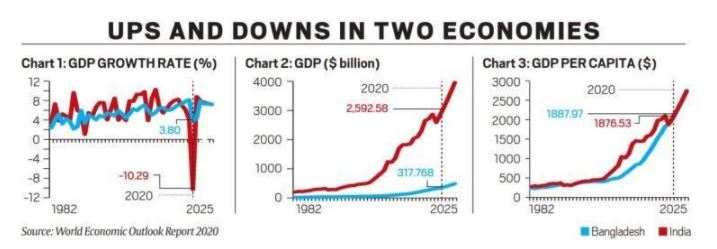
Source: Indian Express
How did this happen? Isn’t India one of the world’s biggest economies?
- Typically, countries are compared on the basis of GDP growth rate, or on absolute GDP.
- India’s economy has mostly been over 10 times the size of Bangladesh, and grown faster every year, as can be seen in Charts 1 and 2
- However, per capita income also involves another variable — the overall population — and is arrived at by dividing the total GDP by the total population.
- As a result, there are three reasons why India’s per capita income has fallen below Bangladesh this year.
- First, since 2017 onwards, as Chart 1 shows, India’s growth rate has decelerated sharply while Bangladesh’s has become even faster.
- Secondly, over the same 15-year period, India’s population grew faster (around 21%) than Bangladesh’s population (just under 18%).
- The combined effect of these two factors can be seen in how the per capita GDP gap had closed considerably even before Covid-19 hit (Chart 3).
- Bangladesh’s per capita GDP was merely half of India’s in 2007 — but this was just before the global financial crisis. It was roughly 70% of India’s in 2014 and this gap closed rapidly in the last few years.
- Lastly, the most immediate factor was the relative impact of Covid-19 on the two economies in 2020. While India’s GDP is set to reduce by 10%, Bangladesh’s is expected to grow by almost 4%.
- In other words, while India is one of the worst affected economies, Bangladesh is one of the bright spots.
Has this ever happened earlier?
- Yes. In 1991, when India was undergoing a severe crisis and grew by just above 1%, Bangladesh’s per capita GDP surged ahead of India’s. Since then, India again took the lead.
Is India expected to regain the lead again?
- Yes. The IMF’s projections show that India is likely to grow faster next year and in all likelihood again surge ahead.
- But, given Bangladesh’s lower population growth and faster economic growth, India and Bangladesh are likely to be neck and neck for the foreseeable future in terms of per capita income.
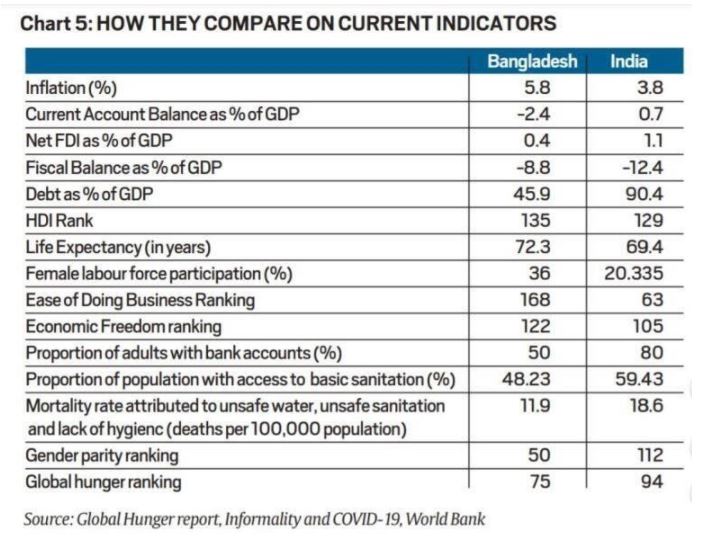
Source: Indian Express
How has Bangladesh managed to grow so fast and so robustly?
- In the initial years of its independence with Pakistan, Bangladesh struggled to grow fast. However, moving away from Pakistan also gave the country a chance to start afresh on its economic and political identity.
- As such, its labour laws were not as stringent and its economy increasingly involved women in its labour force. This can be seen in higher female participation in the labour force
- A key driver of growth was the garment industry where women workers gave Bangladesh the edge to corner the global export markets from which China retreated.
- It also helps that the structure of Bangladesh’s economy is such that its GDP is led by the industrial sector, followed by the services sector. Both these sectors create a lot of jobs and are more remunerative than agriculture.
- India, on the other hand, has struggled to boost its industrial sector and has far too many people still dependent on agriculture.
- Beyond the economics, a big reason for Bangladesh’s progressively faster growth rate is that, especially over the past two decades, it improved on several social and political metrics such as health, sanitation, financial inclusion, and women’s political representation.
Besides the advances it has made, what challenges does Bangladesh face?
- Bangladesh’s level of poverty is still much higher than India’s and still trails India in basic education parameters and that is what explains its lower rank in the Human Development Index.
- The bigger threat to Bangladesh’s prospects emerges from its everyday politics. The leading political parties are routinely engaged in violent oppression of each other.
- In the 2019 edition of Transparency International’s rankings, Bangladesh ranks a low 146 out of 198 countries (India is at 80th rank; a lower rank is worse off).
- Add to this a massive surge of radical Islam, which has resulted in several bloggers being killed for speaking out unpopular views.
- These developments have the ability not just to arrest Bangladesh’s progressive social reforms that have empowered women but also to derail its economic miracle.
(TEST YOUR KNOWLEDGE)
Model questions: (You can now post your answers in comment section)
Note:
- Correct answers of today’s questions will be provided in next day’s DNA section. Kindly refer to it and update your answers.
- Comments Up-voted by IASbaba are also the “correct answers”.
Q.1 Which of the following is not a member of ASEAN?
- Brunei
- Cambodia
- Myanmar
- Bhutan
Q.2 Consider the following statements:
- National Authority of Ship Recycling will be set up in Alang, Gujarat.
- Alang’s beaches have become currently the world’s largest ship graveyard.
Which of the above is or are correct?
- 1 only
- 2 only
- Both 1 and 2
- Neither 1 nor 2
Q.3 Consider the following statements:
- Goods and Services Tax was introduced through the 100th Constitutional Amendment Act, 2016.
- According to GST Compensation Act, 2017, States would be compensated for any loss of revenue in the first five years of GST implementation including any natural disaster arising out of act of God.
Which of the above is or are correct?
- 1 only
- 2 only
- Both 1 and 2
- Neither 1 nor 2
Q.4 Which of the following are covered under 28% slab of GST?
- Fresh fruits and vegetables
- Cereals
- Raw silk
- Tobacco products
ANSWERS FOR 16th October 2020 TEST YOUR KNOWLEDGE (TYK)
| 1 | D |
| 2 | B |
| 3 | A |
| 4 | A |
Must Read
About Gupkar declaration of mainstream J&K political parties:
About IMF’s world Economic Outlook:
About India-Spain relationship:











